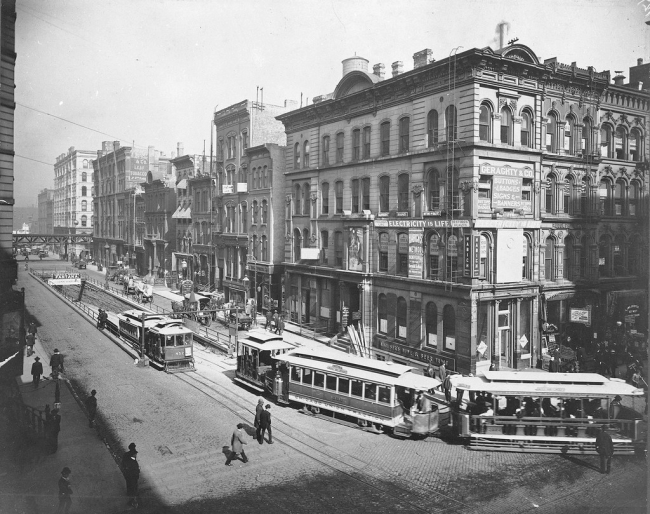It consisted of ten companies recruited in different Midwestern states, Company "D" being from Michigan. Seth and Prosper enlisted in late 1861, and Gilbert in September 1862. The regiment first operated in Northern Missouri; five companies would see their first action there at Mount Zion Church. In February 1862, they were shipped to Fort Henry shortly after its capture, taking part in the capture of Fort Donelson.
 |
| Sergeant Seth A. Bowe (left) and brother Gilbert S. Bowe. Note the sack coats tucked into their trousers. |
The Western Sharpshooters went on to see action at Shiloh and in the Luka-Corinth Campaign. In late 1862, they were transferred to Illinois service, becoming the 66th Illinois Volunteer Infantry (Western Sharpshooters). Seth A. Bowe was discharged on June 17, 1862, due to disability, Gilbert enlisted on September 1, 1862, and Prosper remained in service and reenlisted on December 24, 1863. That December, 470 men reenlisted, and the regiment was sent to Chicago to be given a veteran furlough.
 |
Prosper O. Bowe in civilian clothing. Date unknown. |
All four siblings were born in Jefferson County, New York; the family moved to Michigan in 1855.
After the reorganization in early 1864, the 66th Illinois Sharpshooters returned to Pulaski, leaving for Chattanooga in April. From there, they would travel to the Army of Tennessee in Georgia and see action in the Atlanta Campaign.
Being sharpshooters, they saw much skirmishing throughout the campaign and were heavily engaged on July 22, 1864, at the Battle of Atlanta.
The 66th Illinois was known for being equipped with Henry repeating rifles. Prosper wrote to his sister about how he put his Henry rifle to good use in the Battle of Atlanta, "I stood and fired nearly ninety rounds without stopping. My gun was so hot I could not touch it - spit on it... and it sizzled!"
The 66th Illinois finally participated in the March to the Sea and Carolina's Campaign (May 7, 1864 - December 2, 1864).
They marched in the Grand Review at Washington on May 24, 1865, and were discharged from service on July 7, 1865. All three brothers survived the war; Prosper and Gilbert mustered out with the regiment on July 7, 1865.
Compiled by Dr. Neil Gale, Ph.D.
THE BOWE FAMILY
Seth A. Bowe:
Birth: February 20, 1837, Watertown, Jefferson County, New York, USA
Spouse: Nellie H. Walton Bowe (1850-1931)
Death: March 21, 1905, Oshkosh, Winnebago County, Wisconsin, USA
Burial: Riverside Cemetery, Oshkosh, Winnebago County, Wisconsin, USA
Prosper O. Bowe:
Birth: March 26, 1842 - Clayton, Jefferson County, New York, USA
Death: March 25, 1923, USA
Burial: Watervliet Cemetery, Watervliet, Berrien County, Michigan, USA
Birth: February 20, 1837, Watertown, Jefferson County, New York, USA
Spouse: Nellie H. Walton Bowe (1850-1931)
Death: March 21, 1905, Oshkosh, Winnebago County, Wisconsin, USA
Burial: Riverside Cemetery, Oshkosh, Winnebago County, Wisconsin, USA
Prosper O. Bowe:
Birth: March 26, 1842 - Clayton, Jefferson County, New York, USA
Death: March 25, 1923, USA
Burial: Watervliet Cemetery, Watervliet, Berrien County, Michigan, USA
Early LifeProsper O. Bowe was born on March 26, 1842, in Clayton, Jefferson County, New York. He was part of a close-knit family, having two brothers (Seth and Gilbert) and a sister (Dorcas). At some point, likely during his childhood, the Bowe family relocated to Michigan.
Civil War: A Call to ServiceThe outbreak of the American Civil War likely ignited a strong sense of duty within Prosper. In 1861, he enlisted in Company D of the 66th Illinois Volunteer Infantry. This regiment, originally known as Birge's Western Sharpshooters, was recruited across various Midwestern states and had a reputation for highly skilled marksmen.
Campaigns and BattlesProsper's service with the 66th Illinois involved participation in several notable campaigns and battles:
Fort Donelson: He was present during the capture of Fort Donelson, a crucial Union victory. Prosper is even noted to have captured the colors of the 3rd Tennessee Infantry, demonstrating his bravery.
Shiloh and Corinth: Prosper and his unit saw action in the bloody Battle of Shiloh and the subsequent Corinth Campaign.
Veteran Status and the Atlanta Campaign: Prosper reenlisted in December 1863, a testament to his dedication. The 66th Illinois participated in the Atlanta Campaign, a series of battles instrumental in the Union's eventual victory.
The Mystery of His Burial SiteUnfortunately, Prosper O. Bowe's final resting place remains unknown.
Prosper Bowe's story is a common experience of countless ordinary men who answered the call during a defining moment in American history. His service and sacrifice deserve to be remembered.
Gilbert L. Bowe:
Birth: April 1844, Watertown, Jefferson County, New York, USA
Spouse: Mary Bowe (????-1926)
Death: January 16, 1921, California, USA
Burial: Los Angeles National Cemetery, Los Angeles, Los Angeles County, California, USA
SISTER: Dorcas Priscilla Bowe Boyer:
Birth: March 20, 1840, Watertown, Jefferson County, New York, USA
Children: Sterling Edward Boyer (1859-1923) & Seymour Albert Boyer (1871-1914)
Death: May 17, 1917, Bangor, Van Buren County, Michigan, USA
Burial: Arlington Hill Cemetery, Bango, Van Buren County, Michigan, USA
FATHER: Horace Bowe:
Birth: November 12, 1802, Connecticut, USA
Death: October 28, 1880, Watervliet, Berrien County, Michigan, USA
Horace moved from Connecticut with his family in 1848 to Watertown, New York, and in 1855 to Michigan, where he settled in Berrien County. Horace died in the home of his son Prosper, with whom he had been living for several years.
MOTHER: Susan Clark Bowe:
Birth: November 5, 1809, Connecticut, USA
Death: November 25, 1882, Watervliet, Berrien County, Michigan, USA





























